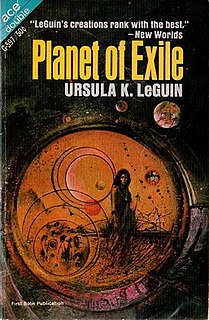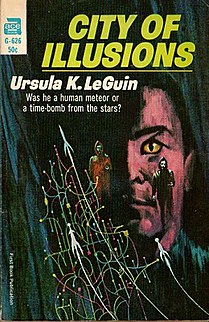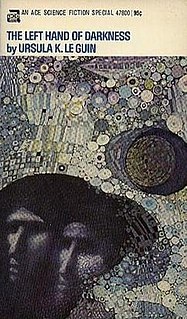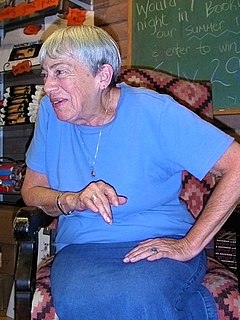An ansible is a category of fictional device or technology capable of near-instantaneous or superluminal communication. It can send and receive messages to and from a corresponding device over any distance or obstacle whatsoever with no delay, even between star systems. As a name for such a device, the word "ansible" first appeared in a 1966 novel by Ursula K. Le Guin. Since that time, the term has been broadly used in the works of numerous science fiction authors, across a variety of settings and continuities.
The Hainish Cycle consists of a number of science fiction novels and stories by Ursula K. Le Guin. It is set in an alternate history/future history in which civilizations of human beings on planets orbiting a number of nearby stars, including Terra (Earth), are contacting each other for the first time and establishing diplomatic relations, setting up a confederacy under the guidance of the oldest of the human worlds, peaceful Hain. In this history, human beings did not evolve on Earth but were the result of interstellar colonies planted by Hain long ago, which was followed by a long period when interstellar travel ceased. Some of the races have new genetic traits, a result of ancient Hainish experiments in genetic engineering, including people who can dream while awake, and a world of androgynous people who only come into active sexuality once a month, not knowing which sex will manifest in them. In keeping with Le Guin's style, she uses varied social and environmental settings to explore the anthropological and sociological outcomes of human evolution in those diverse environments.

Earthsea, also known as The Earthsea Cycle, is a series of fantasy books written by the American writer Ursula K. Le Guin and the name of their setting, a dense archipelago surrounded by an uncharted ocean. There are six Earthsea books written between 1968 and 2001, beginning with A Wizard of Earthsea and continuing with The Tombs of Atuan, The Farthest Shore, Tehanu, Tales from Earthsea, and The Other Wind. Unusually for a series, Tales from Earthsea is a short story collection; the rest are novels. There are also four additional short stories not in Tales from Earthsea.

Planet of Exile is a 1966 science fiction novel by American writer Ursula K. Le Guin, part of her Hainish Cycle. It was first published as an Ace Double following the tête-bêche format, bundled with Mankind Under the Leash by Thomas M. Disch. In 2017, the rights for a movie have been acquired by Los Angeles Media Fund.

City of Illusions is a 1967 science fiction novel by American writer Ursula K. Le Guin. It is set on Earth in the distant future, and is part of her Hainish Cycle. City of Illusions lays the foundation for the Hainish cycle which is a fictional world in which the majority of Ursula K. Le Guin's science fiction novels take place.

The Wind's Twelve Quarters is a collection of short stories by American writer Ursula K. Le Guin, named after a line from A. E. Housman's A Shropshire Lad and first published by Harper & Row in 1975. Described by Le Guin as a retrospective, it collects 17 previously published stories, four of which were the germ of novels she was to write later: "The Word of Unbinding" and "The Rule of Names" gave Le Guin the place that was to become Earthsea; "Semley's Necklace" was first published as "Dowry of the Angyar" in 1964 and then as the Prologue of the novel Rocannon's World in 1966; "Winter's King" is about the inhabitants of the planet Winter, as is Le Guin's later novel The Left Hand of Darkness. Most of the other stories are also connected to Le Guin's novels. The story "The Ones Who Walk Away from Omelas" won the Hugo Award in 1974, while "The Day Before the Revolution" won the Locus and Nebula Awards in 1975.

Four Ways to Forgiveness is a collection of four short stories and novellas by American writer Ursula K. Le Guin. All four stories are set in the future and deal with the planets Yeowe and Werel, both members of the Ekumen, a collective of planets used by Le Guin as part of the background for many novels and short stories in her Hainish Cycle. In 2017 it was reissued as an e-book, augmented with a fifth related story by Le Guin, as Five Ways to Forgiveness.

The Birthday of the World and Other Stories is a collection of short fiction by American writer Ursula K. Le Guin, first published in March, 2002 by HarperCollins. All of the stories, except "Paradises Lost", were previously published individually elsewhere.

The Word for World Is Forest is a science fiction novella by American writer Ursula K. Le Guin, first published in the United States in 1972 as a part of the anthology Again, Dangerous Visions, and published as a separate book in 1976 by Berkley Books. It is part of Le Guin's Hainish Cycle.
"Winter's King" is a science fiction short story by American writer Ursula K. Le Guin, originally published in the September 1969 issue of Orbit, a fiction anthology. The story is part of the Hainish Cycle and explores topics such as the human effect of space travel at nearly the speed of light, as well as religious and political topics such as feudalism.

"The Shobies' Story" is a 1990 science fiction novella by American writer Ursula K. Le Guin, describing the story of the first human crew to participate in a newly invented faster-than-light mode of space travel. It was first published in the anthology Universe 1 and subsequently appeared in A Fisherman of the Inland Sea published by Harper Prism in 1994.

The Left Hand of Darkness is a science fiction novel by U.S. writer Ursula K. Le Guin, published in 1969. The novel became immensely popular and established Le Guin's status as a major author of science fiction. The novel is part of the Hainish Cycle, a series of novels and short stories by Le Guin set in the fictional Hainish universe, which she introduced in 1964 with "The Dowry of the Angyar". Among the Hainish novels, it was preceded in the sequence of writing by City of Illusions and followed by The Word for World Is Forest.
Ursula K. Le Guin's Hainish Cycle takes place in a science fiction universe that contains a number of planets, some of which have been explored and made part of an interplanetary group called the League of All Worlds and its successor, the Ekumen; others are explored and re-explored by the League and the Ekumen over a time frame spanning centuries. Le Guin has used approximately a dozen planets as primary settings for her novels; as such they have detailed physical and cultural descriptions. Le Guin reveals in The Left Hand of Darkness that at that narrative-time, there were 83 planets in the Ekumen, with Gethen a candidate for the 84th.

Ursula K. Le Guin (1929–2018) was an American author of speculative fiction, realistic fiction, non-fiction, screenplays, librettos, essays, poetry, speeches, translations, literary critiques, chapbooks, and children's fiction. She was primarily known for her works of speculative fiction. These include works set in the fictional world of Earthsea, stories in the Hainish Cycle, and standalone novels and short stories. Though frequently referred to as an author of science fiction, critics have described her work as being difficult to classify.
The American Anthropological Association defines anthropology as "the study of humans, past and present. To understand the full sweep and complexity of cultures across all of human history, anthropology draws upon knowledge from the social and biological sciences as well as the humanities and physical sciences." However, Samuel Gerald Collins of the Department of Sociology, Anthropology and Criminal Justice, Towson University, writing in the journal Science Fiction Studies has pointed out that:
In 1978, Margaret Mead, empathizing with the concerns of the 60s' counterculture, pointed to a grave deficiency in the science of anthropology: "Anthropology has to date made very meager contributions to man's developing concern with the future". Two decades later, the American Anthropological Association began awarding an annual prize for "Anticipatory Anthropology" in order to ameliorate this shortcoming, what Robert Textor called the discipline's "tempocentrism" – i.e., its concern only "with the past, the ethnographic present, and the actual present."

"Coming of Age in Karhide" is a science fiction short story by Ursula K. Le Guin, first published in 1995. The story is set on the fictional planet of Gethen, the same as Le Guin's 1969 novel The Left Hand of Darkness, and is a part of Le Guin's Hainish cycle. The story explores themes of growing into adulthood on a planet where individuals have no fixed gender identity. Reviewers stated that the story went further than Left Hand in its exploration of gender and sexuality, and was a "quietly feminist" work. It was also described as lacking the "dizzying impact" of Left Hand. In 2002, it was anthologized in the volume The Birthday of the World, along with many other stories exploring marriage and sexual relationships.
"Vaster than Empires and More Slow" is a science fiction story by American author Ursula K. Le Guin, first published in the collection New Dimensions 1, edited by Robert Silverberg. It is set in the fictional Hainish universe, where Earth is a member of an interstellar "League of Worlds". The anthology was released in United States in 1971, by Doubleday Books.
"The Dowry of the Angyar" is a science fiction short story by American writer Ursula K. Le Guin, first published in 1964. It is the first work of the Hainish Cycle. The story is set on a fictional planet of the star Fomalhaut, and follows a highborn woman as she tries to track down a family heirloom. It was framed by commentary from ethnologists studying the intelligent life-forms of the Fomalhaut system. The story drew from Norse mythology, and explored the concept of time dilation. "The Dowry of the Angyar" drew comments for its stylistic devices, while a review praised Le Guin's writing as "crystalline prose". It was later used as the prologue to Le Guin's 1966 novel Rocannon's World. In later publications, the story was given the title "Semley's Necklace".

"Old Music and the Slave Women" is a science fiction story by Ursula K. Le Guin. It was first published in the 1999 collection Far Horizons, edited by Robert Silverberg, and anthologized multiple times in collections of Le Guin's works. The story is set on the planet of Werel in the fictional Hainish universe, created by Le Guin. That planetary system is also the setting for Le Guin's 1995 story suite Four Ways to Forgiveness. The economy of Werel is based on slavery, and during the period in which the stories are set, the society is experiencing upheaval and revolution.
















